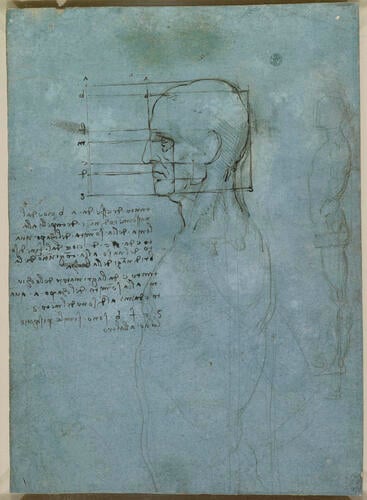-
1 of 253523 objects
The proportions of the head, and a standing nude c.1490
Metalpoint, pen and ink, on blue-grey prepared paper | 21.3 x 15.3 cm (sheet of paper) | RCIN 912601
-
A drawing of a nude man seen to below the waist, turned in profile to the left. His head is more finished and squared for proportion. A note on the proportions of the head. To the right is a full-length figure of a nude man standing in profile to the left, and in the lower left corner is a seated child, of which only the head is clearly visible.
During the 1480s Leonardo became increasingly interested in the scientific basis of painting. Here he attempts to find correspondences of length between parts of the face, without the use of fractions:
It is as far from a to b, that is, from the start of the hair at the front to the line of the top of the head, as it is from c to d, that is, from the lower end of the nose to the junction of the lips at the front of the mouth.
It is as far from the tearduct of the eye m to the top of the head a, as it is from m to below the chin s.
s c f b are equal to one another as to distance.
Leonardo inked over the metalpoint outlines to clarify the diagram, adjusting the line of the back of the cranium to make the depth of the head (from the line touching the brow, lips and chin, and thus omitting the nose) equal to the height of the face. He placed the eye at the mid-point of the head and divided the face into three equal sections, from the base of the chin to the base of the nose, thence to the brow, and thence to the hairline. Though we now tend to regard such proportional studies as trivial, a close attention to facial proportion is in fact of great importance to the profession of plastic and reconstructive surgery.The head also displays prominently anatomical landmarks typical in Leonardo’s work – the sternocleidomastoid and trapezius muscles, the superciliary arch and the angle of the mandible. The rough metalpoint sketch to the right again emphasises the importance of alignment of the parts in a convincing depiction of a standing individual.
Text adapted from M. Clayton and R. Philo, Leonardo da Vinci: Anatomist, 2012, no. 17Provenance
Bequeathed to Francesco Melzi; from whose heirs purchased by Pompeo Leoni, c.1582-90; Thomas Howard, 14th Earl of Arundel, by 1630; probably acquired by Charles II; Royal Collection by 1690
-
Creator(s)
Acquirer(s)
-
Medium and techniques
Metalpoint, pen and ink, on blue-grey prepared paper
Measurements
21.3 x 15.3 cm (sheet of paper)
Object type(s)
Other number(s)
